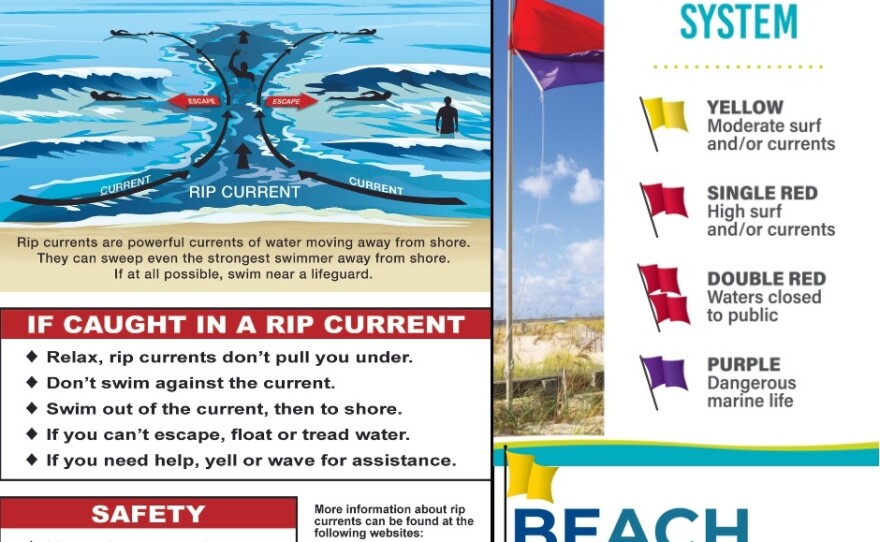Click Here for Live Cam from South Padre, TX: Beryl
Since the start of summer, almost a dozen people have been killed due to rough seas and dangerous rip currents in the US. Most of those deaths have been in Florida, where out-of-state vacationers ventured into water that was too rough. According to the National Oceanic and Atmospheric Administration, rip currents lead to more than 80% of all water rescues. But during hurricane season, when the weather's hot and people are looking to cool off, distant tropical storms and hurricanes can increase your risk of drowning. Here's South Carolina Public Radio's digital meteorologist Leslie Hudson with more.
According to NOAA, nationwide there have already been 17 deaths from rip currents this year alone, with 10 of those being in the South. In Florida, rip current deaths are the number 1 killer above all of the weather hazards including flooding, hurricanes, tornadoes, and even lightning, combined.
If you find yourself caught in a rip current, by far the most important thing to do is to stay calm, and even try to relax. They can be scary, but rip currents will only pull you along, they won't pull you under the water. The biggest danger is tiring yourself out. Don't panic or thrash about. Don't bother trying to fight the current. You may be able to get out of the current by swimming with it parallel to the shore (or just floating or treading water) until it fades or circulates back to shore, and then you can swim to the beach. You also can try swimming with the current toward breaking waves, where you may be able to swim for shore.If you can't reach the shore or you're being pulled farther out to sea, or you're getting tired, draw attention to yourself by waving or shouting for help.

The second biggest danger from rip currents is from people trying to rescue someone else and drowning themselves. It's a perfectly natural impulse that may cause more harm than good. If you see someone in that situation:
Get a lifeguard.
If there isn't a lifeguard nearby, call 9-1-1.
Try to tell the victim to stay calm and swim along the shoreline.
If it's possible and you can do so safely, throw the victim something that floats.
Before you even go near the water, check the conditions.
🌊Swells from #Beryl arrive at our beaches Thursday (July 4th). This will lead to an elevated rip current risk at our east-facing beaches for the end of the week. Check the latest surf forecast before heading to the beach - https://t.co/vJX9FPYkn0 #KnowBeforeYouGo #ncwx #scwx pic.twitter.com/eomG7z3ZLq
— NWS Wilmington, NC (@NWSWilmingtonNC) July 2, 2024
At the beach, look for warning flags at beach approaches or lifeguard stations. Red flags mean dangerous rip current activity is expected. Double red flags mean the water is closed to the public.
Rip currents kill over 100 beachgoers in the U.S. each year. When visiting the ocean, you are safest at beaches with lifeguards. Stay #WeatherReady and learn more about rip current safety at https://t.co/mzrxs54Wkj pic.twitter.com/LU5R9aLbsT
— NWS Charleston, SC (@NWSCharlestonSC) June 12, 2024
The South Carolina National Weather Service (SC NWS) says Fourth of July weekend beach goers need to use caution when celebrating at the beach. There will be high likelihood of rip currents developing at Isle of Palms, Folly Beach, Hilton Head and Tybee beach.
More than 75 rescues on NC coast July 4th due to strong rip currents (mainly New Hanover County) but the surf was rough @emeraldislenc too. Seems to be calming down this AM, but still swell sets rolling in from #Beryl. @NWSMoreheadCity #ncwx #encwx #cltwx #scwx pic.twitter.com/dyTDKUMQ04
— Al Conklin WBTV (@AlConklin) July 5, 2024
Extremely dangerous rip currents will continue along the Carolina seaboard and over to the Gulf of Mexico beaches as Beryl moves into the Gulf of Mexico sending long period swells northwestward. Stay up to date using the beach forecast page: http://www.weather.gov/beach





